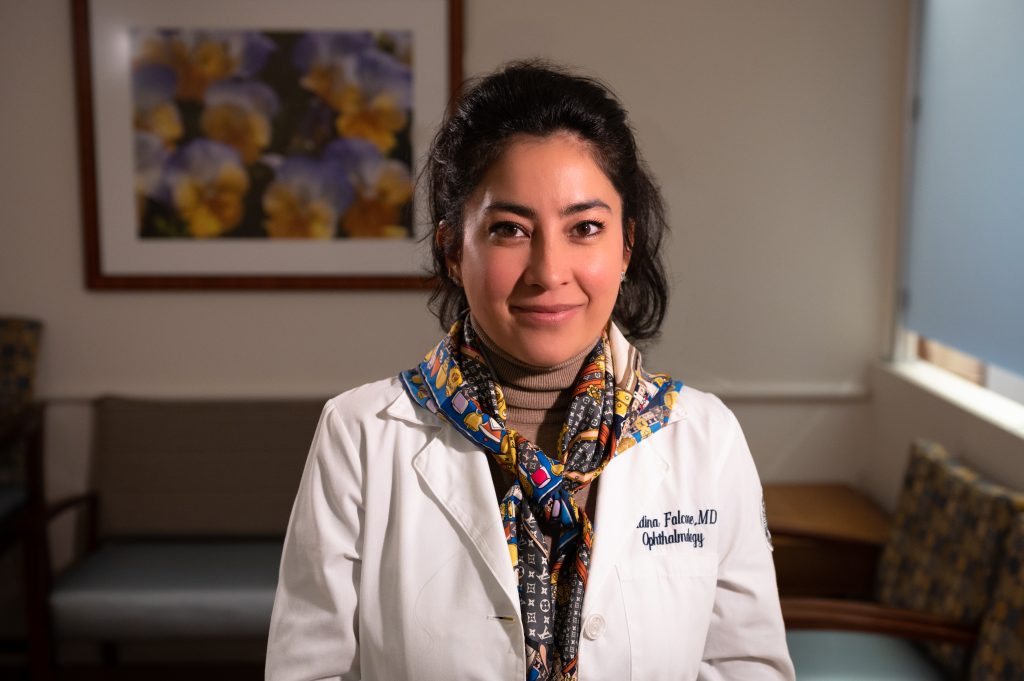By Alix Boyle
Photography Tina Encarnacion/UConn Health
Thyroid eye disease can cause bulging of the eyes, light sensitivity, irritation, dry eye, double vision, and, in extreme cases, decreased vision and possibly loss of vision. It is the most common extrathyroidal manifestation of Graves’ disease or hyperthyroidism, an overproduction of thyroid hormones. Nearly half of patients with Graves’ disease will develop eye problems.
When Dr. Madina Falcone, an ophthalmologist, eye surgeon and specialist in treating thyroid eye disease, first came to UConn Health, patients didn’t have many options for treatment.
“We treated thyroid eye disease with oral or intravenous steroids, with or without orbital decompression surgery to remove bones and fat around the eye. In severe active disease, vision compromise can occur due to compression of the optic nerve and orbital surgery is needed to relieve the pressure on the nerve,” said Dr. Falcone, an assistant professor and director of UConn Health’s Oculoplastics and Orbital Surgery program.
Recently, UConn began offering a groundbreaking treatment that is the only FDA-approved drug specifically designed for the treatment of thyroid eye disease. Teprotemumab, also known as Tepezza, is the first and currently only monoclonal antibody medication that directly targets the orbital tissues and decreases inflammation and congestion that is seen with thyroid eye disease. It is administered as an infusion.
Patients receive an intravenous infusion every three weeks for a total of eight times. In clinical trials, patients experienced a significant improvement in protrusion of the eyes, double vision, inflammation and quality of life. Side effects of the drug are mild. Sugar level abnormalities were noted as the most common side effect. As time went on and more patients received treatment, some patients reported having muffled hearing or hearing loss.
“We’ve learned a little more about this medication and now patients get a hearing screening test as part of the protocol,” Dr. Falcone said. “If hearing changes are detected, we are able to have the help of our otolaryngology colleagues in managing the patients. With tracking and monitoring, we give patients peace of mind, and currently we are experiencing that hearing changes seem to resolve once the medication stops.”
Accessing Tepezza is a process. Everyone on the team at UConn Health—from physicians to nurse navigators—makes the treatment as seamless as possible for patients. First, patients must qualify through their insurance companies to receive the drug. Staff at UConn Health are on hand to help them do it. It typically takes a few weeks.
“Once patients come to me, they get a comprehensive thyroid eye disease evaluation,” Dr. Falcone explained. “They become part of the UConn family and we provide continuity of care and consultations with other specialties including radiology, internal medicine, ear/nose/throat and endocrinology.”
The infusion center at UConn Health is centrally located on campus in easy proximity to the Emergency Department should a need arise. Patients are monitored for an hour after the infusion to see how they’re responding.
Although Tepezza is a promising treatment, it does not fix the problem 100% of the time. Patients may still need surgery, which is generally well-tolerated. People tend to spend only one day in the hospital.
Women outnumber men five to one in the prevalence of thyroid eye disease. It’s estimated that the incidence is 16 per 100,000 in females and 2.9 per 100,000 in males. Smoking worsens thyroid eye disease.
Aside from the physical symptoms, thyroid eye disease causes a lot of emotional distress.
“When they look in the mirror, people don’t recognize themselves,” Dr. Falcone expressed. “Being able to help our patients by having as many treatment modalities as possible is massive. We are getting them back to where they were, looking like themselves again. We are giving them hope.”







More Stories
UConn Health Achieves Excellence in Eye Care in Record Time: Edmund P. Farris, M.D. Chief, Division of Ophthalmology
Specialty Care for Melanoma at UConn Health
Danielle E. Luciano, M.D.: Increasing Awareness and Treatment for Endometriosis